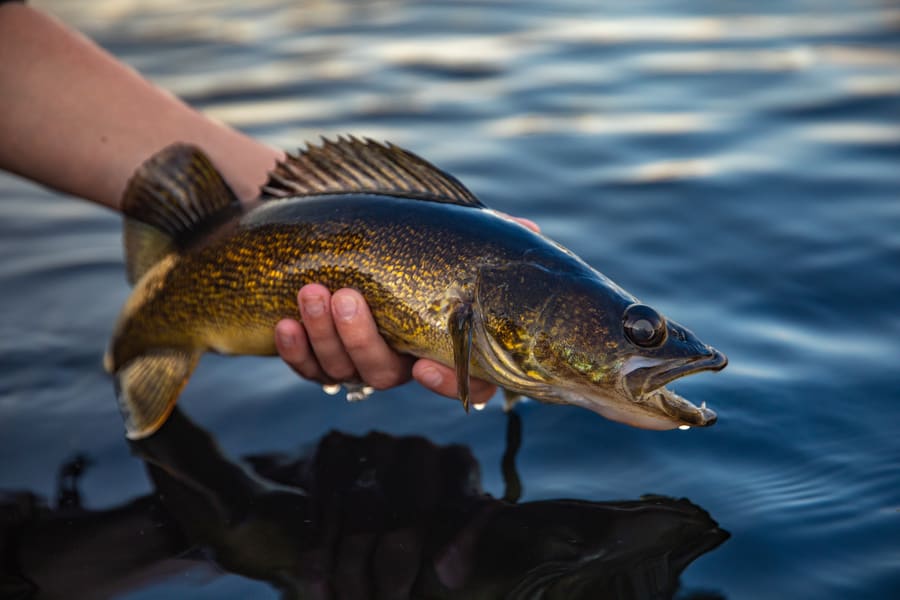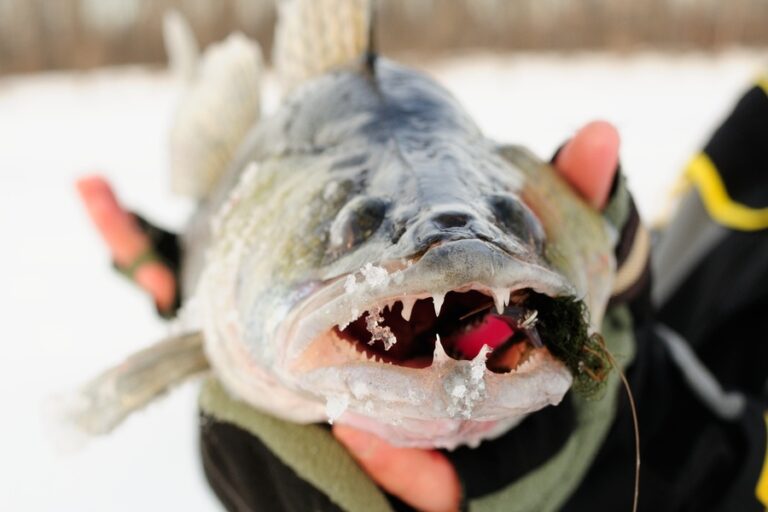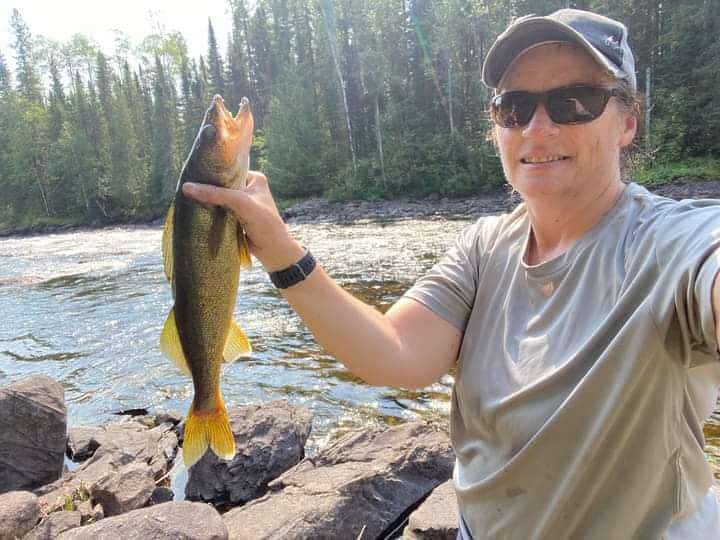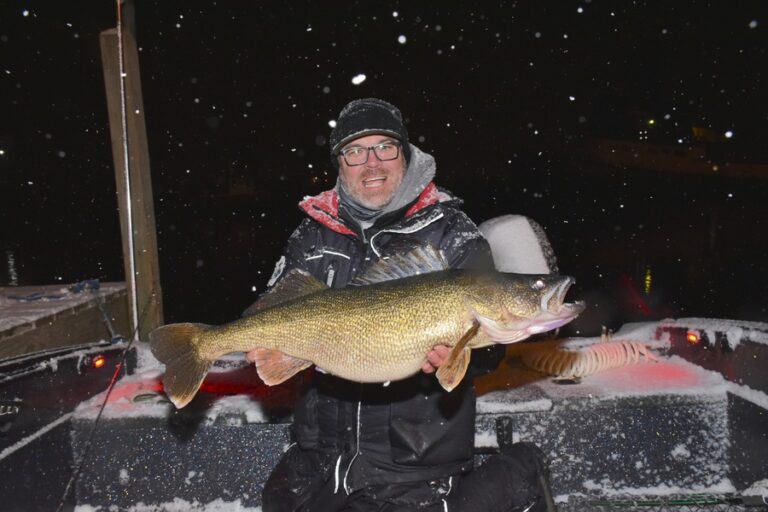Where to Catch Early Morning Walleye (Lakes & Rivers)
Early mornings can offer some of the best walleye fishing of the entire day. However, knowing where to find the biggest pockets of walleyes can make a difference in your success.
At dawn and sunrise, walleye frequent the lake’s shallow edges, nearby underwater rocks, and sandbars. As sunlight increases, walleye backoff towards deeper transitional areas like where sand meets rock or gravel.

Table of Contents
Where to Catch Early Morning Walleye
Knowing where to find and catch walleye in the early morning, from dawn until a few hours after sunrise, can be tricky. Let’s break down each time slot.
Pre-Dawn
About 2 hours before dawn, walleye will be on the hunt for food. Throughout the year, the shallows are where you’ll find pockets of walleyes searching for baitfish. The best season for pre-dawn walleye fishing is spring. Look for rock piles and sandbars in about 4-10 feet of water.
Dawn until Sunrise
As the day’s first light reaches the lake, walleye will shift further from shore. Summer mornings, especially in clearer lakes, can be fantastic during this time window. Look for transitional zones where sandy bottoms give way to rock or structures in about 10-20 feet of water.
This is my favorite time of the morning to fish for walleye. I catch the most fish now during this window before the sun gets above the horizon.
Post-Dawn
Look for walleye to head out into deeper water after sunrise. The warming temps and brightening overhead sun will force the retreat. Start looking for underwater humps, drops, or rock in about 20-30 feet. Early through mid-fall is the prime time to fish for post-dawn walleye in many fisheries.
Click here to learn where to catch walleye. Click here to learn where to catch daytime walleye in rivers.
Seasonal Guide: Walleye Fishing At Sunrise
Spring
The thawing of winter ice brings a fresh start for walleyes, directing them to certain favored areas. Along riverbanks, you’ll often spot them near regions where the river flow eases and where depth variations occur, especially over sandy or gravelly beds they choose for spawning.
Over in lakes, they gravitate towards shallower regions flanking deeper zones, particularly where the bed is rocky – a hotspot for their reproductive activity. During springtime, Dawn is a promising time for anglers, as walleyes frequent these shallows for feeding and breeding.
They display a distinct preference for shad and perch during these months. Target areas ranging from 4 to 15 feet, guided by water clarity.
Recommended Baits:
- Jig and Minnow Combination:
- Lure/Bait: Live minnow paired with a short-shank jig.
- Color: Bright colors such as orange, chartreuse, or pink.
- Location: Shallow flats, spawning grounds, and near drop-offs.
- Size: 1/8 to 1/4 oz jigs.
- Rapala Original Floating Minnow:
- Color: Silver or gold finishes.
- Location: Gravel or sand substrate areas in rivers, or shallow flats in lakes.
- Size: F7 to F9 sizes.
- Soft Plastic Grubs:
- Color: Natural colors like white, brown, or green.
- Location: Tail-out areas in rivers or adjacent to deeper waters in lakes.
- Size: 3 to 4 inches in length.
Summer
Walleye will adopt a pattern of seeking deeper, cooler waters in the daytime. However, the early dawn hours present an opportunity as they explore the shallows for food. In river terrains, deeper pockets or those with natural obstructions, such as logs, are your go-to spots.
Over in lakes, focus on the boundaries of underwater formations like reefs or ledges, where baitfish, particularly alewives and ciscos, swarm.
The summer dawn might sometimes be unpredictable, but after a night on the cooler side, expect an active walleye bite. Aim for depths from 15 to 25 feet, over substrates blending rock with gravel.
Recommended Baits:
- Crankbaits:
- Lure/Bait: Deep-diving crankbaits such as the Rapala Deep Tail Dancer.
- Color: Patterns mimicking alewives, ciscos, or shad.
- Location: Edges of reefs, ledges, and deep underwater structures.
- Size: 3 to 4 inches in length.
- Spinner Rigs:
- Lure/Bait: Worm harness or minnows.
- Color: Bright hues like chartreuse, red, or fluorescent orange.
- Location: Deep holes in rivers, or the transitional zones between shallow and deep water in lakes.
- Size: Two-hook rigs with 2 to 3-inch blades.
- Slip Bobbers and Leeches:
- Lure/Bait: Live leeches.
- Color: Natural leech color.
- Location: Rock piles, timber, and other submerged structures.
- Size: Use medium-sized leeches.
Fall
The dip in temperatures renders the walleyes more lively all day. Come sunrise, in rivers, they often position themselves where currents have a pronounced break, capitalizing on the bounty of baitfish being carried by the waters.
Now, bluegills and shad become their main targets. In lakes, walleyes migrate towards rocky protrusions and sharp declines adjacent to the deeper parts. Fishing between depths of 10 to 20 feet often yields results, with walleyes favoring regions that mix sandy and gravelly beds, interspersed with rocks or fallen timber.
Recommended Baits:
- Jerkbaits:
- Lure/Bait: Lures like the Smithwick Rogue.
- Color: Bluegill, shad, or perch patterns.
- Location: Current breaks in rivers and rocky points in lakes.
- Size: 4 to 5 inches in length.
- Blade Baits:
- Lure/Bait: Silver Buddy or Vibrations Tackle Echotail.
- Color: Silver, gold, or combinations of blue and silver.
- Location: Steep drop-offs and deep basins.
- Size: 1/4 to 1/2 oz.
- Live Bait Rigs and Minnows:
- Lure/Bait: Fathead or shiner minnows.
- Color: Natural minnow color.
- Location: Sand and gravel transitions, especially near timber or rocks.
- Size: 2 to 3 inches for minnows.
Winter
Tracking walleyes becomes somewhat more straightforward with most lakes and even rivers at least partially ice-covered. In rivers that resist freezing, your best bet is the deeper regions where the flow is slow, catering to the walleyes’ energy-saving mode.
In lakes, zones that see a sharp drop in depth from the shoreline or underwater mounds and depressions are key. While early morning fishing in winter can test your patience, walleyes exhibit a heightened preference for baitfish varieties like perch and ciscos.
Concentrate on depths spanning 20 to 35 feet, especially in muddy terrains dotted with occasional rocks or timber.
Recommended Baits:
- Jigging Rapala:
- Color: Perch, silver, or gold patterns.
- Location: First drop-offs from shore or underwater humps.
- Size: #5 to #7 sizes.
- Swedish Pimple:
- Color: Silver or gold with red or green accents.
- Location: Deeper waters near mud substrate areas.
- Size: 1/4 to 1/2 oz sizes.
- Live Minnows and Spoons:
- Lure/Bait: Fathead minnows paired with spoons like the Northland Buck-Shot Rattle Spoon.
- Color: Silver, gold, or glow patterns for spoons.
- Location: Deep, slow-moving pools in rivers or saddles in lakes.
- Size: Spoons ranging from 1/8 to 1/4 oz, and minnows 2 to 3 inches in length.
Early Morning Walleye Fishing Tips
- Moonlit Advantage: On nights with a bright moon, walleyes become more active and feed aggressively. This can make early mornings following such nights particularly productive, as they may still be in a feeding mode. However, the opposite can be true. They can be full by the time you start fishing.
- Temperature Transitions: As cooler nights transition to warmer days, walleyes often move to shallower areas. Target transitional zones between deep and shallow waters during these times.
- Low-Light Lures: In the low-light conditions of early morning, opt for lures that have a strong silhouette or produce vibration, like paddle-tail soft plastics or lipless crankbaits.
- Stealth Mode: Walleyes can be skittish in the clearer waters of dawn. Approach your fishing spot with minimal noise and disturbance to avoid spooking them.
- Weather Fronts: Walleyes are sensitive to barometric pressure changes. Fishing just before a weather front can increase activity, as they often feed heavily in anticipation.
- Windy Points: Wind can push baitfish towards points or structures. Walleyes often congregate on the leeward side, waiting to ambush.
- River Mouths: In lakes connected to rivers or streams, walleyes concentrate near these inlets in the morning, capitalizing on the flow of baitfish.
- Follow the Bait: Walleyes’ primary food sources change throughout the year. Be aware of what they’re feeding on and match your lures accordingly.
- Submerged Vegetation: Look for areas with submerged weeds, especially those near deeper water. Walleyes use these as ambush points in the early morning.
- Rocky Transitions: Areas where sand transitions to rock or gravel can be walleye hotspots, as these provide camouflage and a variety of prey.
- Bottom Bouncing: Use bottom bouncers with live bait or spinners in deeper waters. This method keeps the bait near the bottom where walleyes will be lurking.
- Surface Temperature: A slight increase in water temperature can trigger feeding. Using a temperature gauge can help you pinpoint these warmer pockets.
- Safety First: Early mornings can be foggy or dim, making visibility low. Ensure you have proper navigation lights and safety gear; always watch for other anglers or obstacles.

Features that Attract Walleye: Early Mornings
Certain features in lakes and rivers draw walleye in during the early morning hours. To understand why, let’s dive into the five main features that attract walleyes in the early mornings.
Drop-offs & Ledges
These are prime early-morning walleye features. Look for drop-offs and ledges in 10-20 feet of water. They offer quick access to deep water for safety and the shallows nearby attract baitfish. Spring is the best season to fish these as big numbers of walleye will feed here to prepare for their spring spawn.
Weeds Beds near Open Water
Submerged weeds offer many hiding spots for shallow-water baitfish like perch, bluegill, and shiners which can be prime walleye meals early in the morning. Walleye cruise the deeper water near the edges of these weeds. The deepest edges will be between 5-15 feet in depth. Summer is the best season to hit weed beds for walleye.
Rock Piles
Rocks provide shelter and offer an abundance of insects, crayfish, and small baitfish. Walleye are drawn to rock piles in the early fall season when they put on weight before winter. Look for transitions between gravel and large rocks in about 10-25 feet of water early in the morning near sunrise.
River Inlets & Outlets
In early winters just before full ice, creek inlets/outlets are excellent spots for morning walleye fishing. They offer a great source of warmer water, especially after rainfall, and pour food into the lake. Fish in water depths 5-10 feet near the mouth of these inlets.
Sand-to-Stone Transition Zones
Underwater transitions of sand into rock are a great spot to catch big morning walleyes from late winter into mid-spring. The sand offers access to invertebrates and the rocks will be warmer, which draws in baitfish and walleye. The best transition zones are 10-20 feet for the best fishing.
FAQs: Early Morning Walleye Questions
Where are walleye in early mornings?
In the early morning, walleye are often found in shallower waters near the shore or around underwater structures like rocks and sandbars.
How deep are walleye in the morning?
During the morning, walleye usually stay between 4 to 20 feet deep, depending on the sunlight and water clarity.
What bait colors work best on walleye in the early morning?
Bright colors like orange, chartreuse, and pink tend to be effective for walleye in the early hours, especially if the water is murky. If the water is clear, go for ghost colored baits that look very natural.
How does water temperature affect walleye behavior in the early hours?
Cooler water temperatures can make walleye more active and likely to come to shallower depths, while warmer waters might push them deeper.
Is there a difference in early morning walleye behavior between lakes and rivers?
Yes, in lakes, walleye often roam around underwater features, while in rivers, they are found in areas with slower current or near the riverbed structures.
How does the moon phase impact early morning walleye activity?
The moon phase can influence fish activity. Around a full moon, walleye might be more active at night and less so in the early morning. However, new moons can boost their morning activity.





